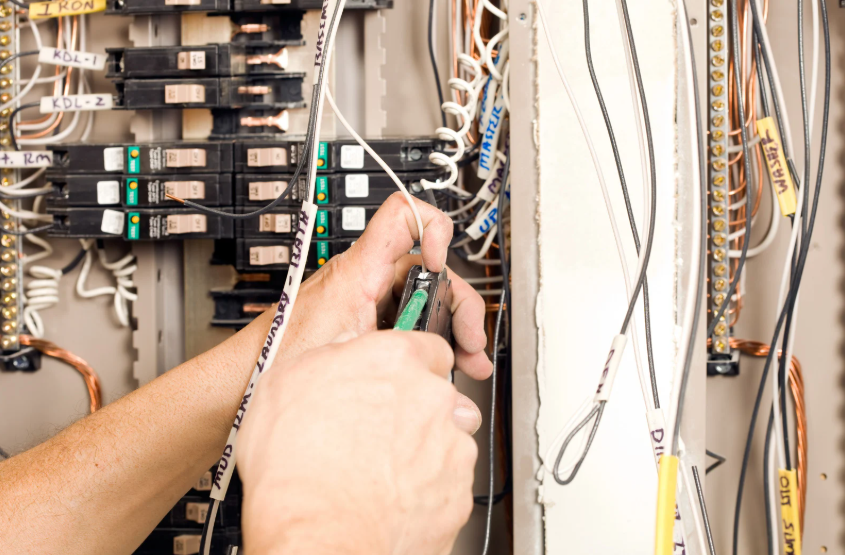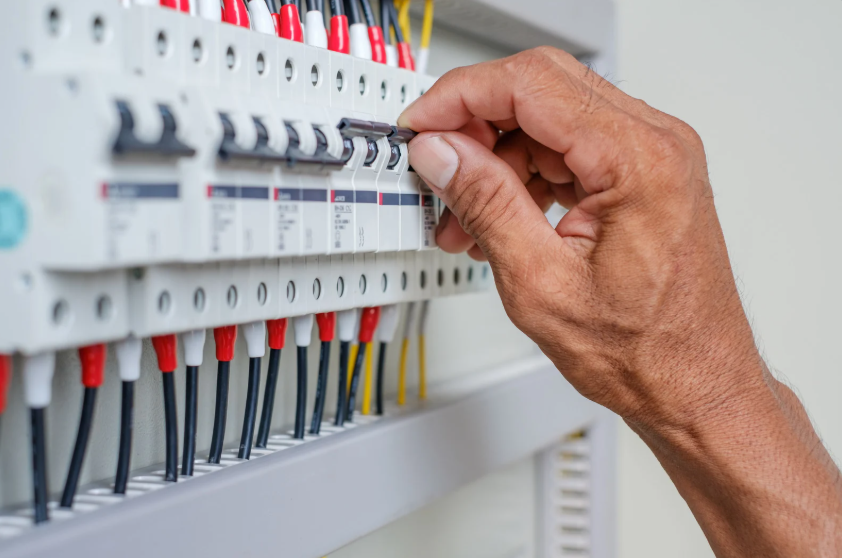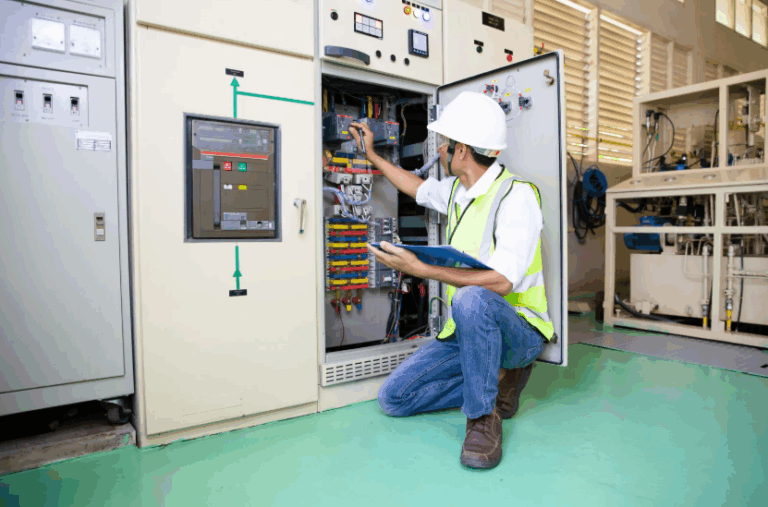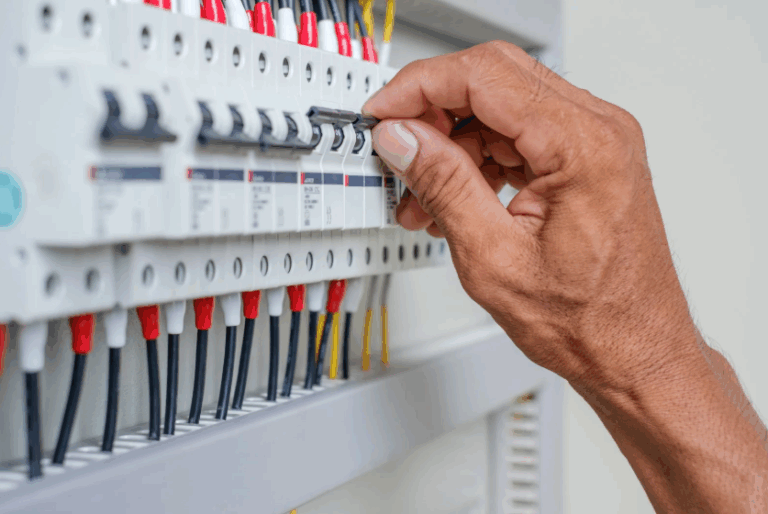Circuit breakers are essential for keeping your home’s electrical system safe. They act as protective devices that automatically shut off power when there’s an overload or short circuit, preventing potential hazards such as fires or electrical damage. However, like any other electrical component, circuit breakers can wear out over time or develop faults that compromise their effectiveness.
A tripped circuit breaker can be a common issue, but the good news is you can often fix a circuit breaker yourself. If you’re noticing that your circuit breaker isn’t working properly, you might be wondering how to tell if it’s bad. In this guide, we will walk you through the steps to fix a circuit breaker and address the common causes of circuit breaker trips.
Common Causes of Circuit Breaker Trips
To effectively fix a circuit breaker, you should first understand the common reasons it might trip:
- Overloaded Circuit: If too many appliances are using power from the same circuit, it can trip the breaker.
- Short Circuit: A short circuit occurs when a live wire touches a neutral wire, causing a dangerous surge of electricity.
- Ground Fault: A ground fault happens when a live wire touches the ground or another conductive surface, often causing a breaker to trip.
Step-by-Step Guide to Fix a Circuit Breaker
Here are the steps you need to take to fix a circuit breaker:
1. Turn Off All Appliances
Start by turning off all devices connected to the affected circuit. This will prevent further damage to appliances or wiring when you reset the breaker.
2. Locate the Circuit Breaker Panel
Find the breaker panel, which is usually located in the basement, garage, or utility room. Open the panel to inspect the breakers.
3. Identify the Tripped Breaker
The tripped breaker will either be in the “off” position or somewhere between “on” and “off.” This is the breaker that needs to be fixed.
4. Reset the Circuit Breaker
To fix a circuit breaker, flip the switch to the “off” position and then back to the “on” position. You should hear a click, which means the breaker has been successfully reset.
5. Check for Power Restoration
Once the breaker is reset, turn on your appliances one by one to check if the power is restored. If the breaker stays on, you’ve successfully fixed it.
6. Monitor for Repeated Trips
If the breaker trips again, it could indicate a deeper issue, such as an overload, short circuit, or ground fault. In this case, you may need to perform further troubleshooting.
Additional Troubleshooting for Fixing a Circuit Breaker

If your circuit breaker continues to trip after resetting it, here are additional steps to take:
1. Reduce the Load on the Circuit
Unplug any unnecessary devices to avoid overloading the circuit. If multiple devices are on the same circuit, try redistributing them across other circuits.
2. Inspect for Short Circuits
A short circuit can cause frequent trips. If you suspect this is the issue, look for any damaged wires or outlets. It’s often best to call a professional electrician for this type of problem.
3. Check for Ground Faults
If the breaker trips immediately upon resetting, it may be due to a ground fault. Inspect outlets and devices for potential issues. GFCI outlets can often trip in such cases and may need to be reset.
What Signs Indicate a Faulty Circuit Breaker?
Your circuit breaker is one of the most important safety devices in your home. When it stops functioning properly, it puts you and your property at risk. Here are the key signs that indicate your circuit breaker may be faulty:
1. Frequent Tripping
If your circuit breaker trips more often than usual, it’s a clear indication that something’s wrong. A breaker trips when there’s an overload, short circuit, or fault, cutting off the power supply to prevent damage. But if it trips repeatedly without any apparent reason, it may be malfunctioning.
- Tip: Try to assess the load on the circuit before resetting the breaker. It could be an overloaded circuit causing the tripping.
2. Difficulty Resetting
Once a breaker trips, you should be able to reset it by flipping the switch back to the ON position. If your breaker won’t reset easily or immediately trips again after resetting, this is a sign of a deeper problem, such as internal damage or a fault in the breaker mechanism.
- Actionable Tip: If resetting doesn’t work after several attempts, don’t force the breaker back into position. It’s best to have it inspected.
3. Visible Damage
If you notice visible signs of damage like scorch marks, rust, or any burn marks around the breaker panel, it’s time to replace your circuit breaker. These signs typically indicate overheating or arcing inside the breaker, which can be hazardous.
- Safety Alert: Don’t ignore visible damage, as this could indicate a potential fire hazard or risk of electrical failure.
4. Unusual Noises or Smells
A properly functioning breaker should be silent and odorless. If you hear buzzing, crackling, or sizzling sounds coming from your breaker panel, or if you smell burning or an electrical odor, there may be an electrical fault within the breaker or the wiring behind it.
- Immediate Action: If you hear or smell something unusual, immediately turn off the main power and call a professional electrician for safety.
Could Overloaded Circuits Be the Culprit?
One of the most common causes of circuit breaker problems is overloading. This happens when too many devices are drawing power from a single circuit, causing the breaker to trip in order to prevent overheating.
How to Prevent Overloading
- Spread out the load: Try not to plug multiple high-wattage appliances (like space heaters or microwaves) into a single circuit. Spread them across different circuits in your home to avoid overloading.
- Know your limits: Make sure your breaker’s rated capacity matches the appliances you have connected to it. If the breaker trips frequently due to high power consumption, consider redistributing appliances to other circuits.
Tip: If you find that your home often experiences overloaded circuits, you might want to upgrade your breaker panel to accommodate higher demands.
Are Your Appliances Causing Breaker Issues?
Sometimes the culprit isn’t the breaker, but a malfunctioning appliance. Faulty appliances can cause frequent trips in the circuit breaker. Here’s how to check:
Troubleshooting Appliances
- Unplug everything: Start by turning off all appliances and lights on the circuit that’s tripping. This isolates the problem.
- Reset the breaker: After turning everything off, reset the breaker.
- Plug in appliances one by one: Reconnect your appliances and devices one at a time, and monitor the breaker. If the breaker trips after plugging in a specific device, you’ve likely identified the faulty appliance.
- Replace or repair: Faulty appliances often need repair or replacement to prevent further issues.
Is Your Breaker Panel Outdated or Damaged?
Over time, your breaker panel may deteriorate or become outdated. A panel that’s older than 20 years or shows signs of wear can lead to frequent tripping or malfunctioning breakers. Here’s what you should look for:
Signs You Need to Upgrade Your Breaker Panel
- Rust or corrosion: Visible rust around the panel or on the breakers themselves.
- Age: If your panel is more than 20 years old, it may not be able to handle the electrical load of modern appliances.
- Frequent trips: If your breakers frequently trip and the problem isn’t a circuit overload, the panel itself might need an upgrade.
Tip: If your panel is old or damaged, it’s a good idea to have a professional electrician inspect it and possibly upgrade it to meet current safety standards.
Step-by-Step Guide: How to Reset a Tripped Circuit Breaker
If your circuit breaker has tripped, it’s possible to reset it yourself with a few simple steps. Let’s go through the process to safely reset the breaker:
Step 1: Identify the Tripped Breaker
Open your electrical panel and locate the breaker that has tripped. A tripped breaker will typically be in the “OFF” position, but it might also be slightly between the “ON” and “OFF” positions. Ensure you correctly identify which breaker is causing the issue.
Step 2: Turn the Breaker Fully Off
Before attempting to reset the breaker, turn it completely to the “OFF” position. This is important because switching it from “ON” to “OFF” resets the internal mechanism, allowing the breaker to restart properly.
Step 3: Reset the Breaker
Once the breaker is fully turned off, flip it back to the “ON” position. You should hear a click when it resets. If the breaker stays in the “ON” position, that means the reset was successful.
Step 4: Test the Circuit
After resetting the breaker, test the devices and outlets on the affected circuit. Plug in a lamp or turn on an appliance to check if power has been restored. If the breaker trips again, there is likely an ongoing issue with the circuit that requires further troubleshooting.
Troubleshooting a Breaker That Won’t Reset
If your breaker won’t reset, it’s time to troubleshoot and take the necessary steps to ensure your home’s electrical system is safe. Follow these steps:
1. Identify the Tripped Breaker
Look for the breaker that is out of alignment with the others, usually in the middle or off position.
2. Turn Off All Devices on the Circuit
Before resetting, unplug all appliances and turn off lights connected to the circuit. This ensures that the breaker isn’t overloaded when you try to reset it.
3. Reset the Breaker
Flip the breaker to the OFF position, wait a moment, then switch it back to the ON position.
4. Check for Immediate Tripping
If the breaker trips again immediately after resetting, there may be an issue beyond an overload, such as faulty wiring or a malfunctioning breaker.
5. Troubleshoot the Circuit
Unplug appliances and plug them back in one by one to identify which one is causing the trip.
6. Call an Electrician
If the breaker continues to trip or if you suspect a wiring issue, it’s crucial to call a qualified electrician to prevent electrical hazards.
When Should You Replace a Faulty Breaker?
A faulty breaker should be replaced when:
- It frequently trips without overloads.
- It’s physically damaged, like burnt or scorched marks.
- It won’t reset after multiple attempts.
- It makes unusual sounds or emits an odor.
Tip: Don’t wait to replace a malfunctioning breaker. Ignoring the issue could lead to more severe problems, including electrical fires or damage to your electrical system.
How to Maintain Your Circuit Breaker for Longevity
Regular maintenance is key to prolonging the life of your circuit breakers. Here’s what you can do to ensure they last as long as possible:
- Avoid Overloading: Spread out heavy appliances across different circuits to avoid overloading one circuit.
- Inspect Regularly: Check your circuit breaker panel for signs of wear and tear at least once a year.
- Keep the Panel Clean: Dust and debris can cause issues, so make sure the breaker panel stays clean.
- Call a Professional: Have your circuit breakers inspected by a licensed electrician if you suspect any issues or notice any of the warning signs listed above.
When to Call a Professional Electrician
While you can troubleshoot certain issues yourself, some situations require the expertise of a professional. Call an electrician if:
- The breaker continues to trip even after following troubleshooting steps.
- You hear buzzing or crackling noises.
- There are visible signs of damage, such as scorch marks or rust.
- You’re unsure about handling electrical work safely.
A licensed electrician can safely diagnose and repair issues with your electrical system.
Conclusion
A faulty circuit breaker is not something to ignore, as it could lead to serious electrical hazards. By recognizing the warning signs and understanding how to troubleshoot, you can ensure your home’s electrical system is running smoothly and safely. If you’re ever unsure or need professional help, don’t hesitate to call an electrician. Your safety is always the top priority.
FAQ
What to do when a tripped breaker won’t reset?
If your breaker won’t reset, first unplug all devices connected to the circuit, then try resetting. If it trips again, there may be a fault, so call an electrician.
How long does it take for a tripped breaker to reset?
It takes seconds to reset a breaker. Wait a few minutes for appliances to cool before resetting to avoid overloading.
How long do you have to wait to reset a circuit breaker?
You can reset immediately if the issue is fixed. If needed, wait a few minutes for appliances to cool down before resetting.
How many times can you reset a tripped breaker?
Reset a breaker once to check for the issue. Repeated resets can cause damage or a fire. If it trips again, call an electrician.
What is the most common cause of a tripped breaker?
The most common cause is overloading the circuit, especially with high-wattage devices like space heaters and microwaves.




